
វិច្ឆិកា . 07, 2024 02:16 Back to list
curved clay roof tiles
Curved Clay Roof Tiles A Timeless Architectural Element
In the world of architecture, a roof serves not just as a protection from the elements, but also as a defining feature of a building’s aesthetic and character. Among the myriad of roofing materials available, curved clay roof tiles have earned a cherished place in both traditional and modern architecture. This distinctive roofing solution combines functionality with timeless beauty, making it a preferred choice across diverse architectural styles.
Curved clay roof tiles, often referred to as Roman tiles or Spanish tiles, are made from natural clay which is molded into curved shapes and then fired in a kiln. This ancient method of production results in durable tiles that can withstand harsh weather conditions while providing excellent insulation properties. The unique curvature of these tiles enables them to interlock efficiently, creating a robust roofing system that is not only aesthetically pleasing but also effective in water drainage. This innovative design helps to prevent leaks and accumulate less debris, ultimately prolonging the lifespan of the roof.
Historically, clay tiles have roots that stretch back thousands of years. Civilizations such as the Romans and the Chinese utilized clay in tile-making, showcasing its versatility and enduring appeal. The curved form was developed to facilitate easier installation and more effective water runoff while ensuring that roofs could endure the test of time. Today, the continued use of curved clay roof tiles speaks to their practicality and the aesthetic advantage they bring to buildings.
The color palette of curved clay tiles ranges widely, from classic terracotta hues to sleek modern shades, providing architects and homeowners with a wealth of design options. This versatility allows clay tiles to complement various architectural styles, including Mediterranean, Gothic, and contemporary designs. The natural earthy tones also blend seamlessly with the environment, creating a harmonious appearance that synthetic materials often struggle to achieve.
curved clay roof tiles

Aside from their aesthetic benefits, curved clay roof tiles are also environmentally friendly. Made from abundant natural resources, these tiles are recyclable and have a low carbon footprint throughout their lifecycle. Their insulating properties help in reducing energy consumption—keeping interiors cooler in summer and warmer in winter—making them an eco-conscious choice for sustainable building practices.
Moreover, maintenance of clay tiles is relatively low compared to other roofing materials. Occasionally, tiles may need cleaning or replacing if damaged. However, their durability often means that they can last for decades, providing both beauty and functionality without frequent replacements.
In recent years, the trend towards sustainable and aesthetically pleasing architecture has resulted in a revival of interest in traditional building materials, such as curved clay roof tiles. As homeowners and architects alike seek to create structures that are not only resilient but also beautiful, these timeless tiles remain a popular choice. The combination of durability, elegance, and ecological responsibility ensures that curved clay roof tiles will continue to grace roofs around the world for many years to come.
In conclusion, curved clay roof tiles offer a unique blend of tradition and modernity, merging aesthetic values with practical benefits, making them an excellent choice for any architectural endeavor.
-
Rubber Roofing Shingles - Durable & Weatherproof SBS Rubber Asphalt Shingles for Homes & Businesses
NewsJul.08,2025
-
Crest Double Roman Roof Tiles – Durable, Stylish Roofing Solution at Competitive Prices
NewsJul.08,2025
-
T Lock Asphalt Shingles Durable Roofing Solution for Long-lasting Protection
NewsJul.08,2025
-
Top Stone Coated Metal Roofing Suppliers & Manufacturers Durable Stone Coated Metal Tile Solutions
NewsJul.07,2025
-
How Many Bundles of Asphalt Shingles in a Square? Fast Roofing Guide & Tips
NewsJul.07,2025
-
How Long Should a Cedar Shake Roof Last? Expert Guide & Replacement Options
NewsJul.06,2025







